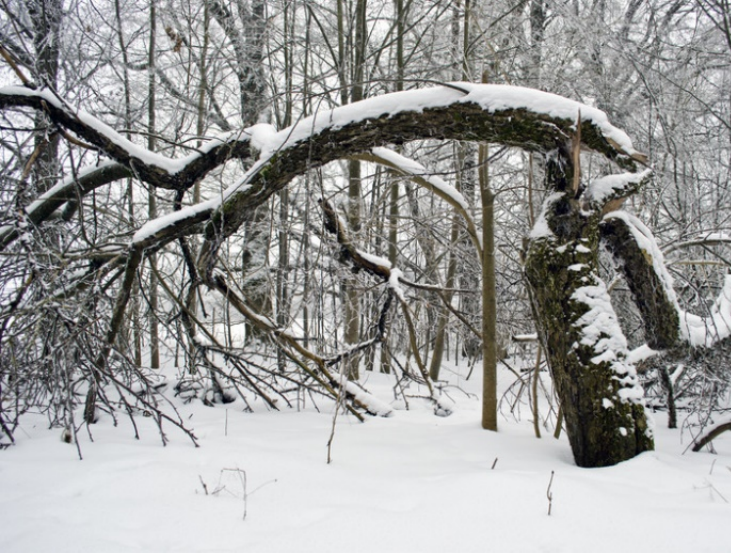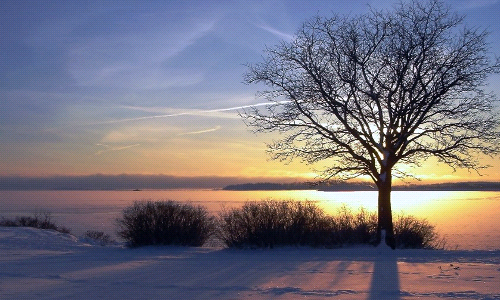During the winter months, conditions for trees can be harsh. When trees start to decline it’s not normally due to one thing, but rather a combination of things. These different elements put the tree under stress. A tree under stress is more susceptible to disease, pests, and keeps it from effectively transporting nutrients. The cold temperatures, snow/ice accumulation, salt being spread on roads, and sun scalding can be detrimental or even fatal to your trees. These damages may be seen immediately, but in a lot of cases the damage won’t be easily noticed until at least one season has passed. There are measures you can take to minimize damage to your trees during these winter months, but not all damage can be avoided. As you continue to read, you’ll learn about common winter-related issues, and we’ll go over some tips to help you mitigate damage.
The freezing temperatures of winter can put your tree under considerable stress because it may not be acclimated to the temperature. In the past couple of years, St. Louis has experienced some late winter/early spring freezes that throw the trees a curve ball so to speak. They’ve been preparing to grow along with the warming weather, and while buds are vulnerable a freeze can do some very considerable damage. Trees that produce flowers are in the most danger come winter time. If it can be helped, plant these trees in an area that has barriers to slow down the wind. This can be anything from a fence, other trees, bushes, a building, etc. Giving these more delicate trees some protection from wind keeps the temperature from fluctuating too rapidly. Just because it’s very cold out doesn’t mean it’s as damaging as a rapid increase or decrease in temperature. This comes back to plant acclimation.
These cold temperatures promote shrinkage in the tree which can cause what is called a frost crack. Frost cracks are caused by uneven shrinkage during a frost. They tend to be deep and are almost always going up or down the tree. The rapid decrease in temperature can cause the outermost layer of the tree to shrink more rapidly than the heartwood of the tree, causing these cracks. This opens the tree up to considerable rot damage deep within the trunk. It would be wise to consult with your ISA certified arborist regarding this damage.


With the lack of foliage in trees during the winter time comes vulnerability. During clear winter days, the sun can come down as bright as any summer day. This combined with freezing temperatures can cause the tree to take on permanent defects to the bark known as sunscald. Younger trees with thinner bark are at higher risk of sunscald than mature trees. It kills the living cells in the bark leaving a very noticeable injury where the bark cracks and eventually falls away. When there is consistent snow on the ground the sun’s rays reflect of the snow which make the possibility of sunscald even higher. Sunscald can be prevented by wrapping the limbs during the winter time, but don’t forget to unwrap them come spring time!
As the temperature drops, ice and snow become a frustrating reality. Now there isn’t really anything to be done about ice, but snow damage can most definitely be minimized! Snow damage generally involves physical breakage of limbs or the whole tree itself. This damage is primarily relevant to ever green trees due to the increased surface area from the year-round foliage. The increased surface area means it collects more snow, making the branches hold a significant amount of weight out towards the tips of limbs. Measures that can be taken to prevent this damage is to gently shake snow fall off the limbs, and even loosely tie limbs together with soft rope or coated twine so that they have more support under the weight of the snow. Remember to remove the string once spring comes around. Depending on the damage the tree has sustained, you will want to contact your ISA certified arborist. By contacting your arborist, you can make sure your tree is getting the proper professional care it needs instead of potentially causing even more damage to your tree by making improper cuts.
To remain safe on our roads during ice/snow fall, we tend to use salt to keep roads from freezing. Now this is convenient but can be incredibly harmful to our trees. As the snow and ice melts, it carries the salt with it into the soil. This increased salt content in the water makes it much more difficult for the tree roots to uptake the water and can even take water out of the tree. The main ways we can minimize this damage is to obviously use less salt, but also to make sure that the soil and surrounding walk ways are thoroughly flushed with fresh water in early spring before the trees start taking in much more water.
Overall, not all winter time damage can be avoided, but there are most definitely measures that can be taken to give your trees the best chance of staying healthy and ready to grow with the changing of winter to spring. If you’d like more personalized and in-depth diagnosis of your landscape’s situation, then it’s a great idea to contact your ISA certified arborist to get reliable, professional help!













